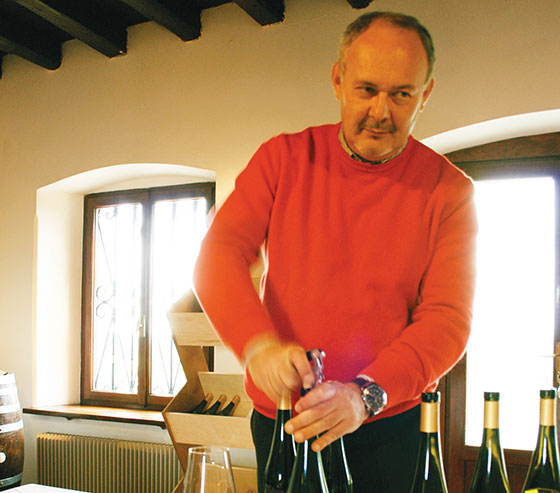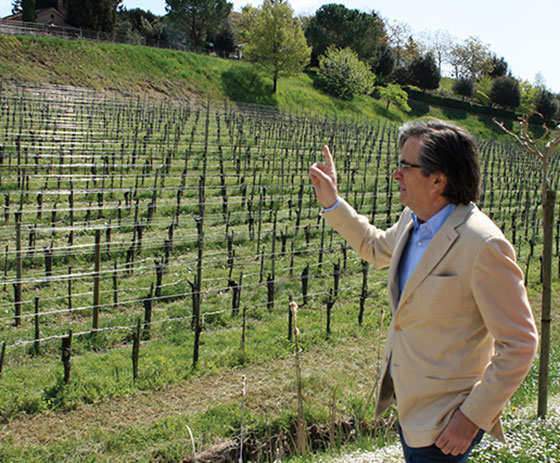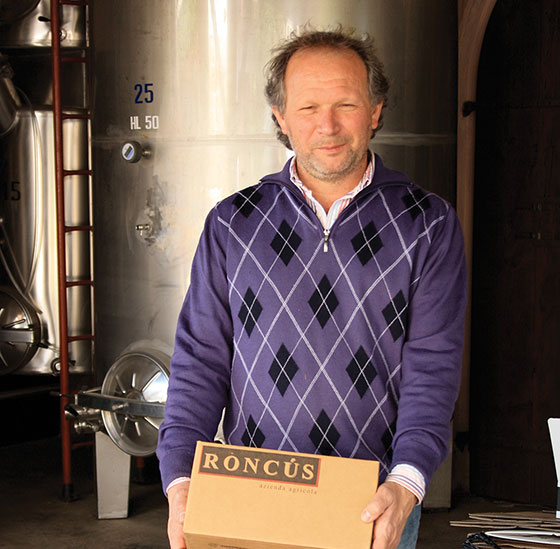White Wine in Italy’s Collio region
by Mary Bailey • photos: Amana LeNeve

Donatella, the jaunty red Fiat 500 rental with The Tomato copy editor Amanda LeNeve at the wheel, has no problem negotiating the narrow curvy roads with the heavily wooded slopes of Slovenia in sight just ahead.
A short while ago this border was heavily guarded, with soldiers, guns, dogs and barbed wire. Those whose property straddled the line needed special permits to work their vines. Now, the border is not a border at all, just an abandoned white control booth with a blue and gold EU sign.
Still, it’s kind of strange. History taught some hard lessons here, there are ghosts. We stop to ask a guy on a tractor for directions, my favourite way to get around.
We’re in the Collio, a range of undulating hills (collio means hills) dotted with vines and small villages in the north eastern reaches of Italy. It’s also known as Collio Goriziano, one of nine grape growing sub-districts in Friuli, known for expressive white wines. Here, white wines outnumber reds by five to one.
It’s early spring. The vineyards are dotted with unfurling grape leaves. The work in the vineyards is maintenance, such as replacing posts, and watchful waiting.
We’ll visit three producers this weekend, by no means an in-depth exploration of the region, but a snapshot of who’s doing what in the Collio.

Piero Totis of Azienda Agricola Poggiobello, Colli Orientali “Don Ziraldo is Friulan,” says Piero Totis, using the Canadian wine pioneer as an example of the 200,000 people who left Friuli between the world wars. Friuli’s loss was Canada’s gain with many Friulan settling in the Toronto area, Vancouver and Edmonton.
Piero, Poggiobello’s export director, is taking us to the estate via the big chair at Manzano (the region is known for high quality chair production); the impeccably restored Benedictine Abbey of the Roses (Abbazia di Rosazzo), then stopping for an early morning espresso and telling us about the bora, the wind that blows in from the southeast.
His knowledge of the region and its history is extensive, as is his knowledge of the vines of Poggiobello. The estate is in Collio Orientali, just to the northwest of the smaller Collio DOC.
“Pinot Bianco is not so popular in the market, but it’s very elegant. Here it grows in a single vineyard on top of the hill. It’s still young. Do you know why it’s called pinot? All the pinot grapes. It’s a British word — the grape cluster looks like a pinecone. From that the French took pineau. Merlot is named after the black bird merlo, that liked to eat the grapes.”
Even in this early stage the vines make a tapestry across the hillside. “There’s Verduzzo, Riesling, Cabernet Sauvignon, Chardonnay, and Pignolo.”

Peiro points out where they are replanting on terraced vineyards called ronca. Vines are planted across the slope, as erosion can be a problem here. “We used satellite temperature maps to help find the best places for each variety. This is especially important for Picolit as it is an uneven ripener.”
“This is a very good place for Sauvingon Blanc,” says Piero, “like Marlborough and the sud Tirol. In the past five years we have had excellent wines from two or three different clones. We take several days to harvest each and vinify separately.”
Back at the winery we taste several wines from both Poggiobello and the sister estate Torre Rozazza.
“Friulano is a big bunch and a consistent ripener, 25 per cent of our harvest,” says Piero. It’s also delicious, tasting of stone fruit and wildflowers, refreshing, with good mouth feel and a long finish.
The Ribolla Gialla is another grape native to Friuli. It grows as a big bunch of bright yellow grapes, and is known for high acidity and long aging potential. Poggiobello’s is beautifully structured, with zesty aromas of green apple, peach and spicy florals.
The Poggiobello Ribolla Gialla and Friulano are available in Alberta.

Roberto Felluga of Russiz Superiore, Capriva del Friuli
Roberto Felluga’s roots are deep in the Collio, reaching back to the republic of Venice and the Austro- Hungarian empire. Now, the family wine business has three branches: Livio Fellugo’s large estate in Friuli, and Robert’s sister Patrizia is the president of the Collio consorzio. Fitting, considering that their father Marco is called the father of the Collio, spearheading the formation of the DOC.
Robert’s winery Marco Felluga has vineyards in four villages of the Collio DOC: Farra, San Floriano, Oslavia and Cormòns, plus the Russiz Superiore, clustered around the cellar in the heart of the Collio near Capriva del Friuli. This is where we meet Roberto Felluga and colleague Martina Camuffo on a sunny Saturday. We join a group of wine lovers, a bachelor party from Vincenza. They go off with Martina while we join Roberto for a walk in the vines.
He’s a thoughtful man, deeply connected to the region and the vines. He talks about wine growing and his work with the University of Torino. “We make small experiments, in pruning let’s say, we are always learning; he says. Contrary to some organic methods that allow the use of copper sulphates, Robert says, “We don’t use copper. First of all, it’s a heavy metal and we don’t want it in our soil, our water. Also we found that it slows down photosynthesis as it stays on the leaves. Grapes ripen more slowly, not good for us in the Collio. We prefer not to grow by ideology,“ he says.
Back in the tasting room, the conversation is lively. Martina pours while the group talks about the market, wine trends and what is a French grape and what’s not. “Cabernet and merlot are auctono (indigenous) here. It’s a genetic mutation of rootstock,” says Robert.
The final arbiter of quality? “It’s terroir,” Robert says. “We have a unique terroir, our soil, our microclimate, that is the most important thing. Quantity is not important, quality is.”

Marco Perco of Roncus, Capriva del Friuli
“This is my cru,” says Marco Perco, gesturing to a small plot of vines. “Not that one,” dismissing another on the other side of the road. Marco’s posts are pieces of tree, not pre-treated wood; the wildflowers and grass looks lush, the vines more robust, less spindly. “The grasses change monthly throughout the season,” he says.
He points to some fully leafed out vines; “that’s Ribolla Gialla”, then points to the Malvasia which has barely started to show green. He knows these vines intimately. “This is typical Fruilano soil,” he says, while trying to extract a flaky stone from a small ridge. “Ponca, not calcareous — you must chop it up.”
His grandfather grew “grapes, vegetables, milk. Now, only wine” It was 15 years ago when he started farming differently, practicing what he calls rustic agriculture — pretty much in the way of the grandfather. He doesn’t apply any water, preferring to plant according to the microclimat diverso, with no fertilizers. Any treatments used are simple and low impact. Wines are made with hand-picked, fully ripe fruit, using the ambient yeasts, not cultured, and fermentations are spontaneous.
“The quality is best achieved in the vineyard, in the cellar the important thing is to do no harm, only to help only show the personality of the wine.”
Marco talks, ably translated by his assistant Michaela Gregorig, while walking quickly up and down the slope, reaching down to pick up bits of rock, pointing to a just- budding-out leaf, frowning at some disturbance in the ground. “It’s the cinghiale,’ says Michela. “It’s not so bad that they eat grapes but they make such a mess, uprooting vines, pulling out posts, they trash the vineyard!” Marco goes on to explain that because his vineyards are surrounded by forest, they take the brunt of the night attacks of the roving wild pigs who make their home in the woods. He laughs and shakes his head when I ask if he can shoot them. “My friend’s mother has a really good recipe for polenta with artichokes and cingiale,” Michaela volunteers. (Note to self: ask for that recipe). When milling about vineyards with Italians, it’s not long before the talk turns to food.

Number one in a series of articles on the Collio.
Mary Bailey is a W.S.E.T. wine educator and ISG certified sommelier.